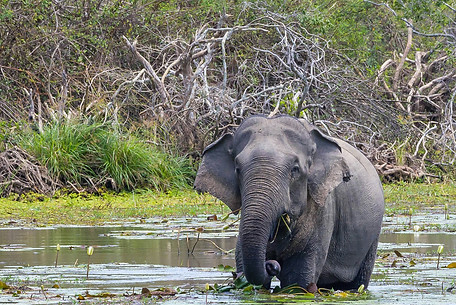Sri Lanka’s National Parks

Yala National Park
Situated in the southeast, spanning Southern and Uva provinces (300 km from Colombo), Yala is Sri Lanka’s most visited and second-largest park. It features diverse ecosystems from monsoon forests to wetlands and coastal areas and harbors Sri Lankan leopards (among the highest densities globally), elephants, sloth bears, and over 215 bird species. A safari here is iconic especially from February to July, when dry-season waterholes attract wildlife

Sinharaja Forest Reserve
Not always labeled a “national park,” but as a UNESCO rainforest reserve it's crucial for conservation. Located in the southwest, Sinharaja is one of Sri Lanka’s last primary rainforests, with over 50% endemic trees and species like purple-faced langur and rare birds such as the red-faced malkoha. Best visited in January – April or August – October when trails are accessible

Wilpattu National Park
Located in the northwest, near Anuradhapura (180 km from Colombo), Wilpattu is Sri Lanka's oldest and largest park. Its signature are the “villus” (natural lakes) drawing leopards, sloth bears, elephants, and numerous bird species. The best time to visit is February to September, with May–July being especially productive for wildlife sightings

Udawalawe National Park
Set in the south-central region, Udawalawe is famous for its large herds of wild elephants seeing them is nearly guaranteed. Also found here are sambar deer, water buffalo, crocodiles, and over 180 species of birds. May to September marks the driest period, though elephant sightings are great year-round

Minneriya National Park
Nestled in the North-Central Province, near Polonnaruwa (~200 km from Colombo), Minneriya is famous for the “Gathering” Asia’s largest congregation of wild elephants, often 200–300 at a time. Also home to birdlife and monkeys, the highlight is the spectacle of elephants at the ancient Minneriya Tank during July to October, especially August–September

Gal Oya National Park
East Uva province, orbiting Senanayake Samudra (Sri Lanka’s largest reservoir), Gal Oya offers unique boat safaris, where you can see elephants swimming between islands, alongside wildlife like crocodiles, spotted deer, buffalo, and birdlife. March to July provides best water levels for boating and wildlife observation

Kaudulla National Park
Close to Minneriya (190 km from Colombo), Kaudulla serves as an elephant migratory corridor, especially between dry-season tanks, hosting up to hundreds of elephants. It’s also an Important Bird Area, with over 160 bird species and additional mammals like sloth bears, leopards, deer, and fishing cats. For best views of the elephant herds at sunset, visit in September to October

Horton Plains National Park
Located at high altitude, near Ohiya and Nuwara Eliya, Horton Plains is a prized UNESCO World Heritage site featuring misty grasslands, montane forests, the dramatic “World’s End” cliff, and Baker’s Falls. You’ll spot endemic species like sambar deer, purple faced langur, and endemic birds. The best time for clear views and comfortable hiking is December to April

Kumana National Park
Adjacent to Yala in the southeast, Kumana is a crucial site for migratory and resident waterbirds, with over 200 species recorded. Rare breeding birds like black necked stork and spoonbills arrive in droves from April to July. Ideal for birdwatchers paired with a Yala safari.

Bundala National Park
On the southern coast, Bundala is a Ramsar wetland and UNESCO biosphere reserve, famous for migratory birds, including thousands of flamingos. Five species of marine turtles nest between October and January, and you can witness hatchling releases from April to June. Year-round birding is good, but December–March is prime

Hikkaduwa National Park
A small marine national park on the southern coast, Hikkaduwa protects a fringing coral reef rich in biodiversity and a natural shoreline break perfect for snorkeling and diving

Wasgamuwa National Park
In Central and North-Central Provinces, Wasgamuwa serves as a major refuge for elephants, sloth bears, and diverse birdlife and is another acknowledged Important Bird Area. It's less crowded, which makes it great for undisturbed wildlife spotting especially elephants




